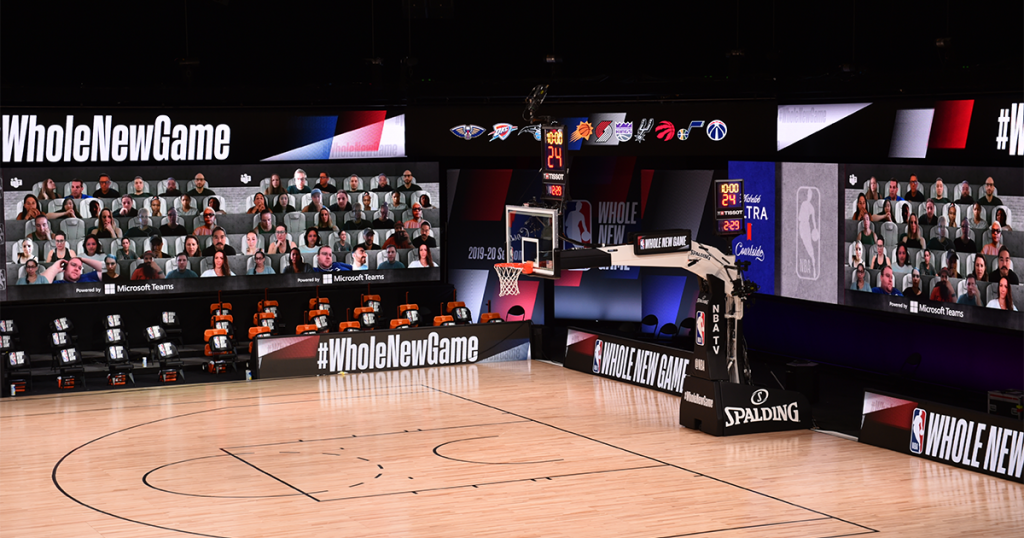Sports teams are getting creative with the fan experience.
The experience for sports fans was already changing and becoming more immersive, even before the novel coronavirus (COVID-19) turned the sports world upside down. Sports events came to a halt, just as most everything else did. As live sports now return—many without fans—we’re witnessing AV taking a front-row seat. Some AV trends that emerged before COVID-19 have now accelerated; meanwhile, new creative approaches have come to the forefront to engage fans virtually.
Sports organizations have long been moving toward creating a more intimate fan experience. Skycam and pylon cameras in the National Football League (NFL) provide camera angles that allow fans to get close-up views of the players and the action on the field. This type of video production becomes much more crucial when there aren’t fans present. Stuart Reynolds, Director of Production and Display, Sports and Live Events, Diversified, said, “We’re always looking for ways to form a camera shot that
doesn’t show hundreds of empty seats, so we might look for new camera angles and ways to get onto the sidelines.”
These broadcasting methods have been in motion for a while, but, now, he said, there’s a greater sense of urgency. As Sound & Communications explores in one of this month’s feature stories (see page 54), the National Basketball Association (NBA) embraced AV when games resumed in late July at the ESPN Wide World of Sports (WWoS) complex near Orlando FL. Because games had to be played without live fans, the NBA developed ways for fans to get as close to the game as possible even from afar. More than 300 fans were invited to attend each game virtually; they appeared live on the “Michelob ULTRA Courtside” 17-foot videoboards surrounding the court. Fans could interact with each other digitally during the games by using Microsoft Teams together mode. In addition, the arena brought in more than 30 cameras—many robotic—to be repositioned closer to the court, thus capturing never-before-seen camera angles for the television broadcasts.
To ensure adherence to social-distancing guidelines, sports venues must determine how to space people out in a facility that, paradoxically, was designed to have people close together. Justo Gutierrez, Director of AV and Sound, Sports and Live Events, Diversified, said that sports venues can spread out fans to the concourses and outside the facility, where external displays can be placed. Some venues are well equipped with AV to adapt more easily; some of them aren’t so well equipped. But Gutierrez
said that older venues that don’t have a lot of AV glitz and glamour, especially on the outside of the building, would have to invest in these solutions.
The new Globe Life Field, home of the Texas Rangers and also featured in this edition of Sound & Communications (see page 42), is an excellent example of a modern multi-use facility. Gutierrez said that, when one walks through the venue, away from the field of play, it has the feeling of a lot of different spaces with high-end finishes. The ballpark is also connected to Texas Live!—an entertainment complex that boasts dining, retail and a hotel, with outdoor video displays for watching the game. Fans can actually walk from Globe Life Field through Texas Live! and find themselves at the Dallas Cowboys’ AT&T Stadium. Sprawling entertainment villages like this not only allow people to spread out, but also provide an experience that just can’t be replicated at home.
So, how else is the fan experience changing? Ticketless entry, contactless payments, and in-seat ordering and delivery are a few ways. Reynolds said that, now, it’s possible to make complex associations about patrons based on the interrelationships of that data. “I think, now, it’s time we move them from the experimental stage of data collection and association into how we can actually benefit the patron’s gameday experience with that data,” he said. If the venue knows what time you typically arrive to the stadium and your favorite drink order, your beverage could be ready for you the minute you come and take your seat, he noted.
There are so many creative ways to make the in-person fan experience far more memorable than viewing a game from home is. Gutierrez predicted that leagues will mic
up more players and capture more incredible camera angles for fans to see and hear only when they attend live.
Although 2020 threw the sports world a curveball, those challenges have spawned some creative uses of AV technology. And we’ll only see more and more of these types of
innovations. According to AVIXA’s market research, the venue-and-events market, which includes sports venues, is forecast to spend $28 billion globally on commercial AV technology and solutions this year, which will increase to $38.6 billion by 2025.
I can’t wait to see what’s next!
To read more from Sound & Communications, click here.
